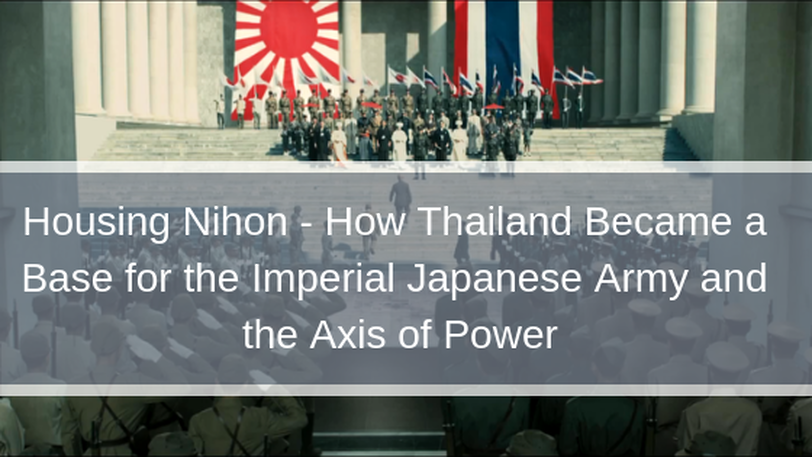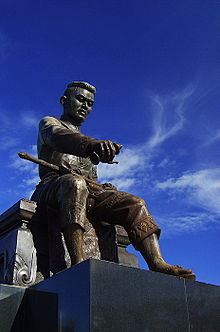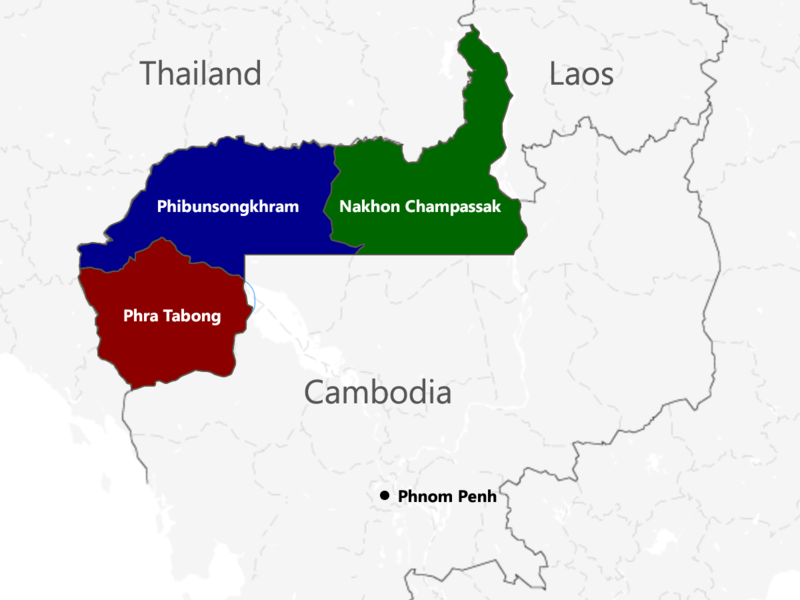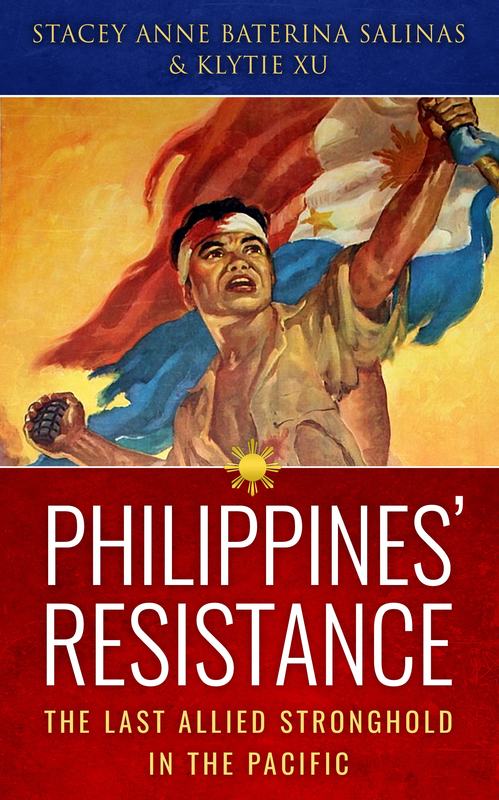Housing Nihon- How Thailand Became a Base for the Imperial Japanese Army and the Axis of Power1/4/2019 by Nickii Wantakan Arcado Thai-Japanese relations can be traced back as early as King Naresuan (1590-1605) reign during the Ayutthaya and Sukhothai dynasty. Stories were told that he defeated the Burmese Prince, Phra Maha Uparaja, with the help of over 500 Japanese Soldiers. How it all began : Pre-War Thailand and Japanese Relationship (continued) During the 1600s, Japan was recorded as one of Thailand’s greatest trading partners. Trade usually involved silk, deer-hide, and shark skin in exchange for Japanese silver and handicrafts. Japan’s frequent visits and economic activities with Thailand challenged the Dutch East India Company’s trading monopoly in Southeast Asia, and by 1620, Thailand was trading with Japan more than any other foreign nation. Japanese communities were also forming in the city of Ayutthaya during the 1620s. As much as 7,000 inhabitants lived in the commune, supervised by Japanese authorities chosen by the Thai government. Some had fled their home following the death of Toyotomi Hideyoshi and Tokugawa Ieyasu (who were great daimyō during the Sengoku period) while other were unemployed samurais hoping to start a new life and find work in Southeast Asia. The colony was valued for its military expertise and experience with the Shogunate, and active forces were deemed "Department of Japanese Volunteers". One of the more prominent individuals who lead this Japanese military group was Yamada Nagasama, a prominent adventurer who gained the trust and loyalty of the Crown King of Thailand. While spending most of his life in the Ayuttaya commune, he was eventually given jurisdiction to the government the province of Nakhon Si Thammarat, furthering positive relationships between Thailand and Japan. By 1630 however, Japan adopted an isolation approach to their foreign policy deemed the Sakoku period. In addition to transforming Thai society as a whole, Thailand’s King Siam Prasat Thong also sought to destroy the Japanese settlements in Ayutthaya. Trade, communication, and societal relationships between Thailand and Japan thus were severed, and the Dutch took over as Thailand’s largest trading partner. No one would imagine that the next encounter between the two countries, would be one of mediation and intervention. How it escalated: The Franco-Thai War The fall of France in June of 1940 provided an ample opportunity for Thai forces to launch attacks in both Laos and Cambodia. Weakened, the French administration was cut off from outside help leaving a power vacuum for their colonies in Southeast Asia. The fighting persisted mostly in the eastern border of the country as well as territories that were previously lost to both the colonial powers of France and the United Kingdom in the nineteenth and early twentieth century. The fighting eventually leads to a stalemate, with neither side presenting a clear victory. It was at this time that Japan intervened, organizing a mediation opportunity titled the “Conference for the Cessation of Hostilities” held in Saigon, Vietnam. The conference contained documented requesting a ceasefire between Marshal Philippe Petain from France and Generals from the Kingdom of Thailand. The ceasefire was signed on January 31, 1941, with an armistice deal arranged to be effective two days prior. By May, a peace treaty between the two parties was signed in Tokyo, where France agreed to relinquish the disputed territories. By March 1941, France ceded over 54,000 square kilometers of Laotian territory west of the Mekong river to Thailand. These also included Battambang and Pailin (renamed Phra Tabong Province), Siem Reap, Banteay Meanchey and Oddar Meanchey (incorporated as Phibunsongkhram Province) and Xaignabouli and Luang Prabang Province (which was renamed to Lan Chang Province). In response to their proposed victory, Thailand build ‘Victory Monument’ (อนุสาวรีย์ชัยสมรภูมิ) a Obelisk monument located in Bangkok, Thailand around the Rachathawi District, one of the most important intersections in the city. The statue, although a popular tourist attraction, many locals recall the history of the monument and the meaning behind it has been reinterpreted and repurposed as a shrine to pray for good luck and wealth. Significantly, the Thai victory over French forces not only allowed for the eventual establishment of Axis power bases in Thailand, but such event marked the first modern victory of an Asian country over a Western nation. How it proceeded: December 8, 1941 and the Occupation Observing Japan’s growth in power within Southeast Asia, Prime Minister Phibun sought support from both the United States and the United Kingdom if Japan were to invade Thailand. While Prime Minister Winston Churchill was in favor of declaring war on Japan if they decided to infiltrate the Kingdom of Siam, the United States was unwilling to agree as the nation still adopted a policy of neutrality during the first years of the war. British forces, fearing that they would not have enough western support in Thailand, therefore, also did not agree to Phibun’s proposition. After days of continuous attacks at the southern border, Japan then moved to occupy Thailand on December 8, 1941. To Japan, Thailand’s location was of strategic importance. The country provided both land and sea passages to Malaya (currently Malaysia) and Burma (currently Myanmar). This provided Japan with logistical and administrative advantages in Southeast Asia compared to their Allied counterpart, as Japan was now capable of launching campaigns from Thailand as well as supply these campaigns more easily. In addition, since Thailand was never colonized by western powers, Japan used the country as an example of what a “free” nation without colonial country could be under Japanese influence. This idea came to be known as Hakkō Ichiu and further expanded to the concept of the Greater East Asia Co-Prosperity Sphere. Many arguments have been debating as to why Thailand decided to agree to house Japanese Axis bases in their territory. The first side argues that the country was coerced, as they were left with the choice to either side with the Japanese who was beginning to conquer lands to both the east and south of Thailand, or refuse and face the wrath of the Japanese Empire as seen through incidents such as the Rape of Nanking. The second argument was that Thailand was pursuing ‘bamboo diplomacy’. Academic argue that during World War II, Thailand adopted clear and solid foreign policies, yet was flexible enough to bend in order to survive. Although the country supported an Axis power, they were rarely involved in the infighting itself and even birthed a large, underground, pro-Allied force movement that helped America infiltrate Japanese forces towards the end of the war. Thailand’s decision during World War II, they argued, was purposefully intentional. What it Affected: Chinese Thai Forced Assimilation Chinese Thais had actively supported and participated in anti-Japanese boycotts due to Japan’s aggressive actions in China prior to World War II. The boycott movement grew more violent when Japan and China announced a full-scale war in 1937. Phibun's government, wanting to maintain positive relations with Japan, worked to suppress the movement. Fearful that protesters would garner more support and therefore, plunge Thai society into chaos, the government initiated and implemented nationalistic policies that weaker Chinese Thais from their homeland and assimilated them to Thai culture. These policies included the closure of Chinese schools, the shutdown of Chinese-language newspapers, and the deportation of politically active individuals. Specifically, in 1941, Thailand enacted a decree which banned Chinese Thais from serving in ‘military sensitive areas’. Unable to garner help from then General Chiang Kai-shek due to Thailand’s refusal to form positive diplomatic relationships, Chinese Thais became what was deemed ‘international orphans’— foreign nationals who had no support from their former homeland and were left with defending themselves. Aware of the lack of political support of Chinese Thais, Japan offered a proposition; abandon their loyalty towards Kai-Shek’s government in China and instead, embrace the Japanese-supported Wang Ching-wei regime in Nanking. Chinese Thais were therefore forced to assimilate to Thai culture, abandoning their Chinese dialect, clothing style, and way of life. How it ended: Post-War Thailand Following Japanese surrender and the end of World War II in 1945, Thailand worked to restore its international reputation. Pridi Phanomyong (who led the Free Thai resistance movement) argued that because Phibun’s declaration of war against the Allied forces was unconstitutional, therefore, it was legally void. Successfully able to garner support from members of the international community—especially the United States who viewed Thailand’s declaration of war as one of coercion and duress—and returning formerly seized lands during both the Franco-Thai war and the onslaught of World War II, Thailand was admitted to the United Nations in 1946. While the country fell under distress and chaos with the passing of King Ananda Mahidol due to a highly controversial gunshot incident, the resignation of Pridi Phanomyong due to the high level of difficulty in investigating the death, and a military coup shortly after, the country overcame its political turmoil and worked its way up to being an ally to western nations. Specifically, during the Cold War, the country served as a buffer zone and bastion against communist forces in Southeast Asia. It also sent troops to assist the United States and Korea during the Korean War, and eventually joined SEATO, the Southeast Asian Treaty Organization that acted as an anti-communist defense force. By the late 1950s, Thailand received massive financial support from the United States, setting up the foundation for the country’s economic boom in the 1990s. Today, while Thai relationships with Japan center mostly around trade deals and tourism, the most relevant topic to date is involving the construction of a new railway line. China initially proposed the Belt and Road initiative, a modern-day ‘silk road’ that would connect Chinese to various economies and countries in both Central and South Asia (via land) and the Middle East and Europe (via sea). The proposed rail line in Thailand will stretch over 873 kilometers (about 542 miles), linking Thailand and Laos. Japan, on the other hand, offered to counter China’s proposed rail project in exchange for ¥170 billion in loans for a similar railway project. Such negotiations are still in the works, but it is interesting to observe a new force of battle taking place; one of soft, economic power. Nonetheless, the strange and peculiar alliance of the strongest East Asian state and the developing Southeast Asian nation during World War II, is one to be noted in history books forever. References:
Related ArticlesRelated Books
2 Comments
6/20/2023 06:26:27 pm
Your sharing of this knowledge is greatly appreciated! The subject is really fascinating. I'm eagerly anticipating your next fantastic update.
Reply
Leave a Reply. |
- Home
- Stories
-
Internship
- Summer 2024 Internship
- Summer 2023 Internship
- Fall 2022 Internship
- Summer 2022 Internship
- Summer 2021 Internship
- Fall 2020- Spring 2021 Internship
- Summer 2020 Internship
- Fall 2019 Internship
- Summer 2019 Internship >
- School Year 2018-2019 Internship
- Summer 2018 Internship >
- Fall 2017 Internship
- Summer 2017 Internship >
- Books
- Archives
-
Resource Page
-
Supplementary Research Guides
>
- Unit 731 - Guide >
-
Philippines' Resistance - Guide
>
- Philippines World War II Timeline
- The Japanese Invasion & Conquest of the Philippines
- Bataan Death March
- Formation of Underground Philippines Resistance
- Supplies of the Guerrilla Fighters
- The Hukbalahap
- Hunter's ROTC
- Marking's Guerrillas
- United States Army Forces in the Philippines of Northern Luzon (USAFIP-NL)
- The Aetas
- Chinese and Filipino-Chinese Nationalist Guerrilla Units
- The Female Faces of the Philippine Guerrillas
- Rising Sun Flag - Guide >
- Pinay Guerrilleras - Guide >
- Fall of Singapore - Guide >
- Three Years and Eight Months - Guide >
- Siamese Sovereignty - Guide >
- The Khabarovsk War Crimes Trial - Guide >
- Unit 731 Cover-up : The Operation Paperclip of the East - Guide >
- Marutas of Unit 731 - Guide >
- Prince Konoe Memoir - Guide >
- Competing Empires in Burma - Guide >
- Battle of Shanghai - Guide >
- Ishi Shiro - Guide >
- Taiwan The Israel of the East - Guide >
- Seeking Justice for Biological Warfare Victims of Unit 731 - Guide >
- Rice and Revolution - Guide >
- Clash of Empires - Guide >
-
Hunger for Power and Self-SufficiencyI - Guide
>
- The Influence of War Rations on Post-War Culinary Transformations
- How World War II Complicated Food Scarcity and Invention
- American Military Innovations
- Government-Sponsored Food Inventions in Europe during World War II
- Feeding the Army: The Adaptation of Japanese Military Cuisine and Its Impact on the Philippines
- Mixed Dishes: Culinary Innovations Driven by Necessity and Food Scarcity
-
Denial A Quick Look of History of Comfort Women and Present Days’ Complication - Guide
>
- The Comfort Women System and the Fight for Recognition
- The Role of Activism and International Pressure
- The Controversy over Japanese History Textbooks
- The Sonyŏsang Statue and the Symbolism of Public Memorials
- Activism and Support from Japanese Citizens
- The Future of Comfort Women Memorials and Education
- Echoes of Empire: The Power of Japanese Propaganda - Guide >
- Lesson Plans >
-
Supplementary Research Guides
>
|
Pacific Atrocities Education
730 Commercial Street San Francisco, CA 94108 415-988-9889 |
Copyright © 2021 Pacific Atrocities Education.
We are a registered 501 (c)(3) charity. |
- Home
- Stories
-
Internship
- Summer 2024 Internship
- Summer 2023 Internship
- Fall 2022 Internship
- Summer 2022 Internship
- Summer 2021 Internship
- Fall 2020- Spring 2021 Internship
- Summer 2020 Internship
- Fall 2019 Internship
- Summer 2019 Internship >
- School Year 2018-2019 Internship
- Summer 2018 Internship >
- Fall 2017 Internship
- Summer 2017 Internship >
- Books
- Archives
-
Resource Page
-
Supplementary Research Guides
>
- Unit 731 - Guide >
-
Philippines' Resistance - Guide
>
- Philippines World War II Timeline
- The Japanese Invasion & Conquest of the Philippines
- Bataan Death March
- Formation of Underground Philippines Resistance
- Supplies of the Guerrilla Fighters
- The Hukbalahap
- Hunter's ROTC
- Marking's Guerrillas
- United States Army Forces in the Philippines of Northern Luzon (USAFIP-NL)
- The Aetas
- Chinese and Filipino-Chinese Nationalist Guerrilla Units
- The Female Faces of the Philippine Guerrillas
- Rising Sun Flag - Guide >
- Pinay Guerrilleras - Guide >
- Fall of Singapore - Guide >
- Three Years and Eight Months - Guide >
- Siamese Sovereignty - Guide >
- The Khabarovsk War Crimes Trial - Guide >
- Unit 731 Cover-up : The Operation Paperclip of the East - Guide >
- Marutas of Unit 731 - Guide >
- Prince Konoe Memoir - Guide >
- Competing Empires in Burma - Guide >
- Battle of Shanghai - Guide >
- Ishi Shiro - Guide >
- Taiwan The Israel of the East - Guide >
- Seeking Justice for Biological Warfare Victims of Unit 731 - Guide >
- Rice and Revolution - Guide >
- Clash of Empires - Guide >
-
Hunger for Power and Self-SufficiencyI - Guide
>
- The Influence of War Rations on Post-War Culinary Transformations
- How World War II Complicated Food Scarcity and Invention
- American Military Innovations
- Government-Sponsored Food Inventions in Europe during World War II
- Feeding the Army: The Adaptation of Japanese Military Cuisine and Its Impact on the Philippines
- Mixed Dishes: Culinary Innovations Driven by Necessity and Food Scarcity
-
Denial A Quick Look of History of Comfort Women and Present Days’ Complication - Guide
>
- The Comfort Women System and the Fight for Recognition
- The Role of Activism and International Pressure
- The Controversy over Japanese History Textbooks
- The Sonyŏsang Statue and the Symbolism of Public Memorials
- Activism and Support from Japanese Citizens
- The Future of Comfort Women Memorials and Education
- Echoes of Empire: The Power of Japanese Propaganda - Guide >
- Lesson Plans >
-
Supplementary Research Guides
>












